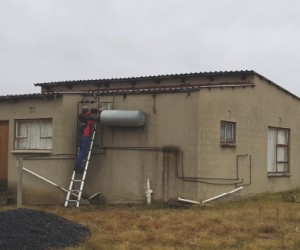With high electricity costs and water shortages as a result of the ongoing drought conditions, innovative technologies have become crucial to conserve and preserve the country’s resources.
South Africa is a water scarce country with severe water shortages in some areas. This problem is compounded by an unintended consequence of making water available affordably across the spectrum of South African citizens—water is not perceived as a scarce commodity. Moreover, due to the way in which information on water consumption is disseminated, awareness of consumption per action and per unit of time is severely constrained. Given the historic inequalities in the country, in some cases, the consumers of the water (domestic cleaners) are not the same person paying the bills, which further compromises the feedback loop.
The Department of Science and Technology (DST) is leading and supporting research and development geared towards producing sustainable technology. One such initiative is the ‘Smart Geyser’ project, which falls under the department’s Innovation Partnership and Rural Development Programme (IPRDP). PRDP is aimed at improving service delivery through science, technology and innovation within the priority rural district municipalities. In support of the Department of Rural Development and Land Reform Comprehensive Rural Development Programme, the IPRDP prioritises innovative technology solutions that aim to improve the access and quality of public service in areas of water, sanitation, energy, information and communications technologies and human settlements within the prioritised district municipalities.
The ‘Smart Geyser’ project seeks to address these water scarcity challenges through a technological intervention by leveraging another consumable commodity, one which has managed to communicate the scarcity through pricing—electricity. The initiative is currently being piloted and, already, the Mkhondo Local Municipality in Mpumalanga is seeing the benefits. Developed by Stellenbosch University and funded by the Department of Science and Technology, the system aims to reduce geyser energy and water use by at least 30-50%. Ordinarily, household water heating makes up roughly 34% of electricity consumption and about 70% of household water consumed passes through or right by the geyser. The geyser system can monitor and control a significant proportion of the water consumed by each household.
Known as “geasey”, the device is attached to a geyser to control electricity. About 150-such devices have been installed by various local plumbers and electricians in the municipal area. “Geaseys” are also installed with a sim card and a modem, which automatically reports to their server where the data is processed and feedback is relayed to the user. The system uses telemetry—an automated communications process by which measurements and other data are collected at remote or inaccessible points and transmitted to receiving equipment for monitoring—that gives remote access to your geyser through a mobile device or personal computer.
It analyses consumption patterns, recommends and applies optimised control schedules, gives water and energy costs for each bath or shower taken and controls the water temperature. It also mitigates a burst through shutting off the water supply when a burst is detected. The devices record usage of approximately 171 000 litres of water and about R15 000 of electricity per month. This intervention is saving about R45 000 per month for Mkhondo Municipality in electricity alone, through scheduling.
By making information about the relationship between water and electricity consumption publically available, the user is made aware of their water consumption patterns, which leads to a change in behaviour patterns and, hopefully, a more sustainable use of the resource. According to Professor Thinus Booysen of Stellenbosch University, the system benefits the user, the utility (Eskom) and third parties in various ways. “The project has enabled us to put the product on the market and, through it, numerous people have been employed”, adds Booysen.
For instance, the user gets the benefit of remote access to their geyser, allowing them to switch it on, off, and to schedule the geyser. Also, the system will protect against geyser mechanical failure. It measures water and electricity consumption in real-time, giving the economically involved user awareness of consumption patterns and a way to adjust behaviour. Finally, it recommends an optimal control strategy with which to control the element. “The system continues to save electricity costs for all participants and helps them to make informed decisions about making water and energy resource savings through behavioural changes,” says Booysen.
Booysen emphasises the significance of building relationships with the users and training them, as they need to be technology-savvy. For Mkhondo municipality, researchers from Stellenbosch University ran a full marketing campaign through different media, including print platforms, pamphlets distribution at local schools, churches, shops and a massive Facebook Campaign.










